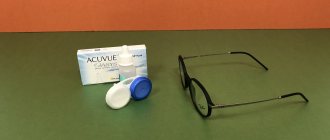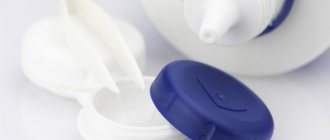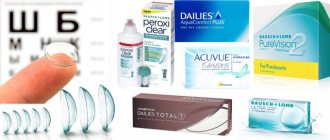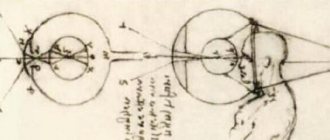Today, contact lenses are one of the most popular methods of vision correction, which will eventually completely replace glasses. Based on this, manufacturers of such optics are developing more and more different models, the purpose of which is to provide comfort and not harm health.
Most often, users have problems with such accessories due to ignoring the wearing mode. Also, with daily wear, users of optical lenses notice redness of the eyes. We'll look at the possible causes and how to remove redness below.
Causes of eye irritation
When wearing contact lenses for a long time, many users notice the appearance of redness of the mucous membranes. For the most part, this manifestation is not the result of an allergic reaction of the body directly to the lenses. For the most part, this is a reaction to the solution with which the optics are processed.
You should also consider possible reasons why your eyes turn red after wearing lenses:
- Periodically wearing lenses for more than the prescribed period. The tight fit of the material to the mucous membrane of the eyes makes it impossible to wear them for more than 10 hours a day.
- Allergy to optical lens care products. When choosing solutions for treating lenses, you should ensure that they do not contain components that can cause allergies.
- Reaction to formations that appear when wearing optics for a long time. In this case, you can clean the lenses using a hydrogen peroxide-based system.
- Injury to the cornea due to improper wearing of contact lenses. In this case, in addition to redness, there may be tearing, fear of light, and pain in the eye area. If such manifestations occur, you should visit a doctor as soon as possible.
We recommend reading: What lenses can you sleep in?
According to ophthalmologists, redness of the eyes is associated with the use of lens care solutions of poor quality or composition that the body does not accept. This means that you should change the product and choose an individual solution.
Brief information about red eye syndrome
What is the reason for the popularity of contact lenses? In them, a person feels more comfortable than glasses and can lead a normal lifestyle, without any restrictions.
The optical device allows you to play sports, does not reduce the field of view, and does not put pressure on the nose and ears. However, the slightest neglect of wearing norms will lead to serious complications and health problems. Red eyes after contact lenses are one of the consequences encountered when recommendations for their use are not followed.
Often, such symptoms signal the development of pathologies such as conjunctivitis, glaucoma, etc. Any deviation from the norm associated with the ocular apparatus requires immediate treatment.
When wearing contact lenses, the eyes often experience oxygen starvation and problems with the normal functioning of the tear film. In this way, favorable conditions are created for the proliferation of pathogenic microorganisms that provoke the development of infectious diseases. The most serious pathology faced by lens wearers is inflammation of the cornea.
| Ophthalmologists do not recommend using vision correction devices on an ongoing basis. It should be worn only when absolutely necessary, with the exception of those lenses that are made of high-quality and “breathable” material. At the first opportunity, take them off and give your eyes a rest. |
Precautionary measures
In order to prevent red eye syndrome, when purchasing optical lenses with a corrective function, you should pay attention to their compliance with the requirements. First of all, lenses must have not only a smooth, uniform surface, but also a soft structure.
Some manufacturers are already using materials that breathe. Such lenses allow oxygen to penetrate the mucous membranes; there is no need to remove them. Breathable materials are used in lenses that can be worn without removing for more than a month.
If this rule is violated, the eyes may react with redness to the unsuitability of the lenses for further wear. This is due to the fact that prolonged wear leads to a loss of elasticity of the structure, as a result of which the worn material irritates the mucous membranes of the eyes.
You should also consider the following measures to help prevent red eyes:
- You need to buy corrective lenses only with a prescription from an ophthalmologist. Wearing corrective lenses unnecessarily can cause deterioration in visual function.
- Proper selection and wearing of lenses will help prevent eye problems. To do this, you should seek help from an ophthalmologist.
It must be remembered that independent selection and prescription of corrective or simple colored lenses is unsafe. You also need to take into account that when you wear it for the first time, your eyes may turn red for no reason until you get used to it.
The true causes of allergies
- Incorrect selection of contact lenses. You need to buy only those lenses that have been selected for you by a medical specialist. You cannot independently select certain items based on their cost or other parameters. When making a purchase, including in online stores, you must strictly follow the prescription, which specifies the exact name of the lenses, diopters, curvature, diameter, as well as other parameters for toric and multifocal lenses.
- Eye allergy to the solution. If you wear daily contact lenses, then this option is excluded. In other cases, symptoms of eye irritation may be caused by the solution. Of course, modern manufacturers strive to use only high-quality materials so that the solutions resemble human tears in their properties, but there are still situations when a patient has an individual intolerance to one or another component.
- Improper care or wearing regimen. Do not wear daily lenses for more than one day, do not forget to clean the lenses, if you are using scheduled replacement models, remove them at night, wear special swimming goggles in the pool, and also follow other recommendations of specialists.
- Other types of allergies. The moment you start using contact lenses may coincide with the development of seasonal allergies, allergies to household dust, animal hair, pollen, etc. In this case, it is necessary to exclude all these types of allergies.
- Diseases of the organs of vision and external factors. Dry eyes can be caused by working in an air-conditioned room, and pain in the eyes can be caused by foreign bodies. There are a number of ophthalmic diseases whose symptoms are similar to those of allergies.
At the first symptoms, you should immediately consult a doctor to rule out the true causes of the allergy. For example, a specialist may recommend that you regularly clean your lenses and moisturize your eyes if you work in a dry environment.
How to remove redness
Before determining a treatment method for red eyes, an ophthalmologist performs a diagnosis. The first step is to determine the condition of the eyes and the quality of visual functions. If there are pathological changes, the doctor may insist on a more detailed diagnosis.
Only a specialist can determine the drugs that can be used to combat red eyes.
Such means are:
- Korneregel - used to normalize visual functions. They are also used to protect the cornea from pressure and pressure sores under the lens. Drops increase moisture levels and prevent drying of the mucous membrane.
- Taufon – due to the presence of an amino acid in the composition, it promotes the healing of microcracks and is used to treat damage to the white part of the eye.
- Emoxipine is a drug intended to create protection for blood vessels and mucous membranes from various types of influences.
- Visine – promotes vasoconstriction, thereby relieving redness of the eyes.
In cases where it is not possible to immediately visit an ophthalmologist, you can use home methods for treatment and as prevention.
These methods include:
- Availability of cleansing eye drops - you need to make sure that there is always such a product in your home medicine cabinet. With its help, you can wash your eyes and disinfect them in case of contact with foreign objects.
- Cold compress – you can use black tea, chamomile, oak bark or potato for this.
- Eye rinsing is done as often as possible. This should be done especially often after contact lenses are removed. Of course, this will not help remove redness, but it will significantly enhance the effect of using medications.
- Changing the solution for treating contact lenses.
- Wearing sunglasses helps protect your eyes from dust, debris, and harmful ultraviolet rays from sunlight.
Why do my eyes sting when putting on contact lenses?
Sometimes, when putting on and taking off contact correction products, the eyes begin to tingle, they can water, and in some cases even hurt. There may be several main reasons for this situation: violation of the manufacturer’s recommendations for use, intolerance to the components of the lens material and solution, external factors.
Let's take a closer look at the most common causes of eye problems that arise when putting on contact lenses. We will also learn what to do to eliminate them and how to avoid possible complications from the visual system when wearing contact optics is problematic.
1. Failure to comply with hygiene rules. Before putting on or removing lenses, you must carefully prepare the area where you are doing this and wash your hands with running water and neutral soap. 2. Ingress of debris - dust particles, lint, cilia - onto the surface of contact optics. It is necessary to rinse the optical product in a multifunctional solution. 3. Accumulation of organic deposits and microorganisms on the surface and in the “body” of the lens material. It is necessary to clean it using enzyme tablets or peroxide solution. 4. Contact of components of disinfectant solutions with the cornea of the eye. It is necessary to rinse the eye, and then strictly follow the instructions for use indicated on the packaging of the product. 5. Microcracks, rupture of contact correction means. Replacement with a new one is required. 6. Non-compliance with the wearing regime, use for longer than the recommended time. It is necessary to select lenses correctly, taking into account the mode of use that is convenient for you. 7. Use of contact optics, care and moisturizing liquids that have expired. Such products must be disposed of and replaced with fresh ones.
8. Incompatibility of the lens material with the tissues of the eye. You need to choose a different type of product. 9. Intolerance to the components of the solution for daily use. You need to visit an ophthalmologist and with his help choose a liquid that does not contain allergenic components. 10. Reaction to components of the buffer solution. Before putting on the lens for the first time, rinse it well with a multifunctional solution that suits you. 11. Exacerbation of seasonal allergies. Additional use of moisturizing drops is recommended; you may need to switch to daily lenses or glasses. 12. Viral diseases, changes in hormonal levels. It is necessary to eliminate the main cause of the disease, increase immunity, in some cases the ophthalmologist may allow the wearing of one-day contact optics. 13. Damage to eye tissue (microcracks, tears, scars, detachment). You need to immediately contact an ophthalmologist to prescribe timely treatment. 14. Work in dusty and smoky rooms. It is recommended to use contact correction products on a daily basis.
MagazinLinz.ru team
Selection of suitable lenses with a doctor
If contact lenses are a vital necessity, then to ensure eye health and prevent redness during their use, it is necessary to choose the right optics.
Only a specialist can select high-quality lenses and determine their diopters correctly. It must be remembered that thoughtless purchases without an ophthalmologist's prescription can negatively affect the quality of vision.
Experts have several basic criteria that you should rely on when purchasing optical lenses. Today, manufacturers offer many new products, including breathable material that can be worn without interruption for about 30 days. You must strictly follow the rules of wearing and do not use lenses for more than the prescribed time. Otherwise, the material becomes thinner and loses elasticity. The result of all this is redness, which is irritation of the mucous membrane.
To avoid problems associated with wearing contact lenses, you should pay special attention to the selection and daily care of optical accessories. Following simple rules will not only help maintain the quality of visual function, but will also extend the life of contact lenses.
Contact lenses for sensitive eyes
When the cause of allergies is intolerance to the materials from which the lenses are made, the doctor will pay attention to models for sensitive eyes when selecting them, and in this case the choice usually falls on daily contact lenses. And if you have a reaction to silicone, then the medical specialist will choose hydrogel lenses.
After replacing one contact lens with another, pay attention to your condition: whether the allergy symptoms have gone away, whether your health has improved. If so, continue to wear the items that make you most comfortable.











